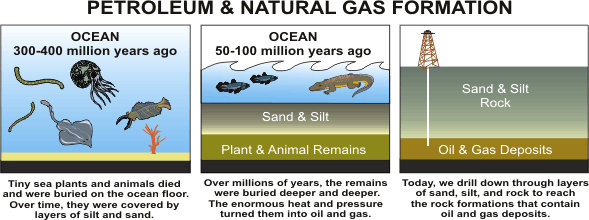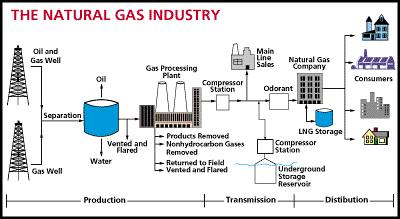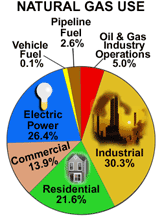|
Natural
Gas Fuel
See
also:
other
readings with assessment in Alternative Energy -- Wind
Energy -- Geothermal Energy -- Hydropower -- Nuclear Energy
--
see
Alternative Energy Basics
|
|
|
How Was Natural
Gas Formed?
Millions of
years ago, the remains of plants and animals decayed and built up
in thick layers. This decayed matter from plants and animals
is called organic material -- it was once alive. Over time,
the mud and soil changed to rock, covered the organic material and
trapped it beneath the rock. Pressure and heat changed some
of this organic material into coal, some into oil (petroleum), and
some into natural gas -- tiny bubbles of odorless gas. The
main ingredient in natural gas is methane, a gas (or compound) composed
of one carbon atom and four hydrogen atoms.

In some places,
gas escapes from small gaps in the rocks into the air; then, if
there is enough activation energy from lightning or a fire, it burns.
When people first saw the flames, they experimented with them and
learned they could use them for heat and light.
How Do We Get
Natural Gas?
The search for
natural gas begins with geologists (people who study the structure
and processes of the earth). They locate the types of rock that
are known to contain gas and oil deposits.
Today their
tools include seismic surveys that are used to find the right places
to drill wells. Seismic surveys use echoes from a vibration
source at the earth’s surface (usually a vibrating pad under a truck
built for this purpose) to collect information about the rocks beneath.
Sometimes it is necessary to use small amounts of dynamite to provide
the vibration that is needed.
Scientists and
engineers explore a chosen area by studying rock samples from the
earth and taking measurements. If the site seems promising,
drilling begins. Some of these areas are on land but many
are offshore, deep in the ocean. Once the gas is found,
it flows up through the well to the surface of the ground and into
large pipelines. Some of the gases that are produced along
with methane, such as butane and propane
(also known as 'by-products'), are separated and cleaned at a gas
processing plant. The by-products, once removed, are used
in a number of ways. For example, propane can be used for
cooking on gas grills.
Because natural
gas is colorless, odorless and tasteless, mercaptan (a chemical
that has a sulfur like odor) is added before distribution, to give
it a distinct unpleasant odor (smells like rotten eggs). This
serves as a safety device by allowing it to be detected in the atmosphere,
in cases where leaks occur.
Most of the
natural gas consumed in the United States is produced in the United
States. Some is imported from Canada and shipped to the United States
in pipelines. Increasingly natural gas is also being shipped to
the United States as liquefied natural gas(LNG).
We can also
use machines called "digesters" that turn today's
organic material (plants, animal wastes, etc.) into natural gas.
This replaces waiting for thousands of years for the gas to form
naturally.
How Is Natural
Gas Stored and Delivered?
The gas companies
collect it in huge storage tanks, or underground, in old gas wells.
The gas remains there until it is added back into the pipeline when
people begin to use more gas, such as in the winter to heat homes.

Natural gas
is moved by pipelines from the producing fields to consumers. Since
natural gas demand is greater in the winter, gas is stored along
the way in large underground storage systems, such as old oil and
gas wells or caverns formed in old salt beds. The gas remains there
until it is added back into the pipeline when people begin to use
more gas, such as in the winter to heat homes.
When
chilled to very cold temperatures, approximately -260 degrees Fahrenheit,
natural gas changes into a liquid and can be stored in this form.
Because it takes up only 1/600th of the space that it would in its
gaseous state, Liquefied natural gas (LNG) can be loaded onto tankers
(large ships with several domed tanks) and moved across the ocean
to deliver gas to other countries. When this LNG is received in
the United States, it can be shipped by truck to be held in large
chilled tanks close to users or turned back into gas to add to pipelines.
When the gas
gets to the communities where it will be used(usually through large
pipelines), the gas is measured as it flows into smaller pipelines
called "mains". Very small lines, called "services",
connect to the mains and go directly to homes or buildings where
it will be used.
How is Natural
Gas Measured?
We measure and
sell natural gas in cubic feet (volume) or in British
Thermal Units (heat content). Heat from all energy
sources can be measured and converted back and forth between British
thermal units (Btu) and metric units. See the Energy
Calculator for help with converting natural gas units.
One Btu is the
heat required to raise the temperature of one pound of water one
degree Fahrenheit. Ten burning kitchen matches release 10
Btu. A candy bar has about 1000 Btu. One cubic foot of natural gas
has about 1031 Btu. A box 10 feet deep, 10 feet long, and 10 feet
wide would hold one thousand cubic feet of natural gas.
How Is Natural
Gas Used ?

Approximately
22 percent of the energy consumption of the U.S. comes from natural
gas. Slightly more than half of the homes in the U.S. use natural
gas as their main heating fuel.
Natural gas
is also an essential raw material for many common products, such
as: paints , fertilizer, plastics, antifreeze, dyes, photographic
film, medicines, and explosives. We also get propane
when we process natural gas. Propane is the fuel many of us use
in our barbecue grills.
Natural gas
has thousands of uses and industry depends on it. It's used to produce
steel, glass, paper, clothing, brick, electricity and much more!
Homes use it
too. More than 62.5 percent of homes use natural gas to fuel stoves,
furnaces, water heaters, clothes dryers and other household
appliances. It is also used to roast coffee, smoke meats,
bake bread and much more.
How Does Natural
Gas Impact the Environment?
Natural gas
burns more cleanly than other fossil fuels. It has fewer emissions
of sulfur, carbon, and nitrogen than coal or oil, and when it is
burned, it leaves almost no ash particles. Being a clean fuel is
one reason that the use of natural gas, especially for electricity
generation, has grown so much and is expected to grow even more
in the future.
Of course, there
are environmental concerns with the use of any fuel. As with other
fossil fuels, burning natural gas produces carbon dioxide which
is a very important greenhouse gas. Many scientists believe that
increasing levels of carbon dioxide and other greenhouse gases in
the earth’s atmosphere are changing the global climate.
Also, as with
other fuels, natural gas also affects the environment when it is
produced, stored and transported. Because natural gas is made up
mostly of methane (another greenhouse gas), small amounts of methane
can sometimes leak into the atmosphere from wells, storage tanks
and pipelines. The natural gas industry is working to prevent any
methane from escaping. Exploring and drilling for natural gas will
always have some impact on land and marine habitats. But new technologies
have greatly reduced the number and size of areas disturbed by drilling,
sometimes called "footprints." Satellites, global positioning systems,
remote sensing devices, and 3-D and 4-D seismic technologies, make
it possible to discover natural gas reserves while drilling fewer
wells. Plus, the use of horizontal and directional drilling make
it possible for a single well to produce gas from much bigger areas
than in the past.
Natural gas
pipelines and storage facilities have a very good safety record.
This is very important because when natural gas leaks it can cause
explosions. Since raw natural gas has no odor, natural gas companies
add a smelly substance to it so that people will know if there is
a leak. If you have a natural gas stove, you may have smelled this
“rotten egg” smell of natural gas when the pilot light has gone
out.
SOURCE : ENERGY
INFORMATION ADMINISTRATION -- DEPARTMENT OF ENERGY -- KIDS HOME
PAGE
TEST
YOUR KNOWLEDGE OF THE MATERIAL
|

